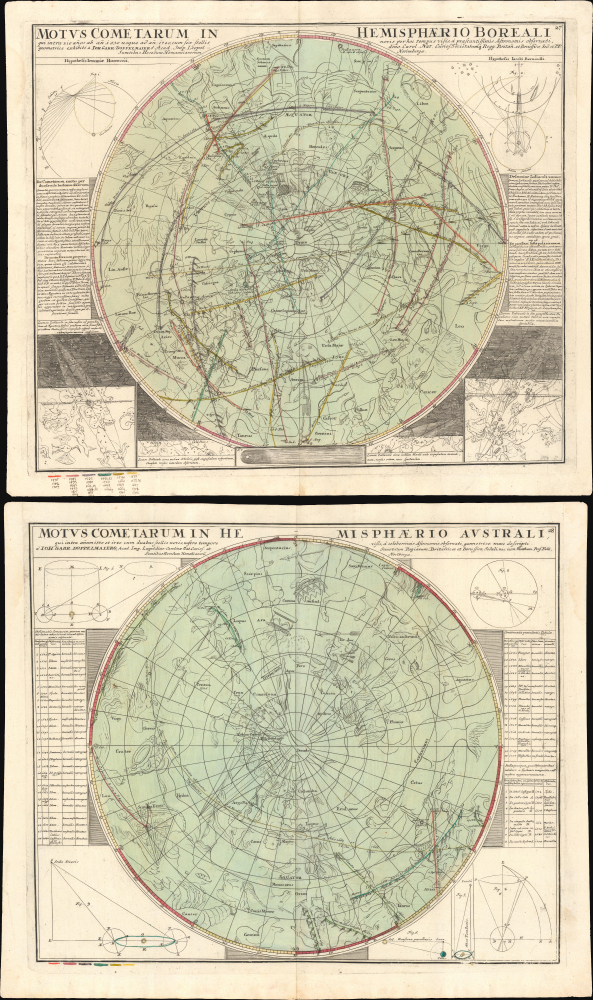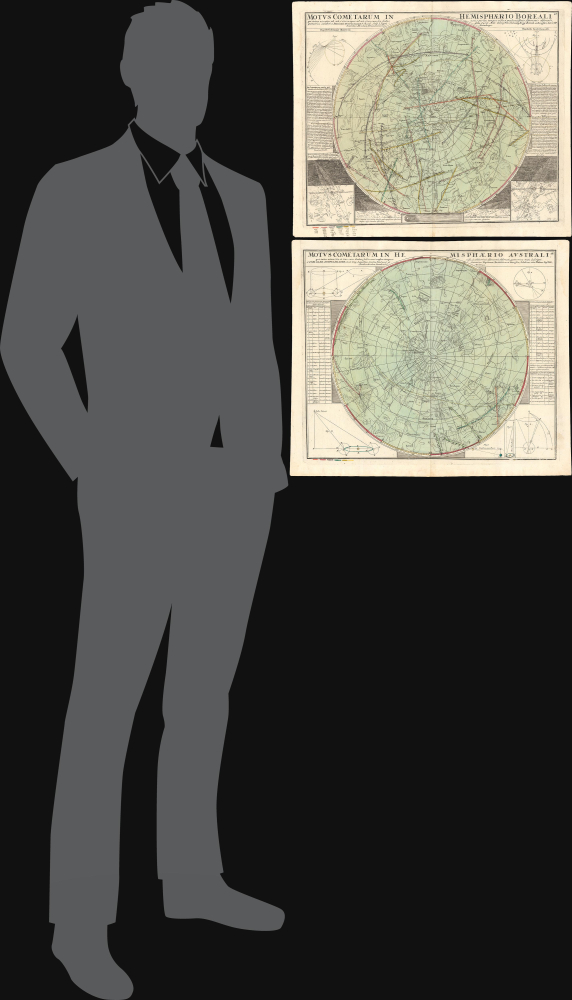1742 Doppelmayr Map Pair of Northern and Southern Celestial Spheres w/Comet Manuscript
Cometarum-doppelmayr-1742
Title
1742 (undated) 22.5 x 27 in (57.15 x 68.58 cm)
Description
A Closer Look
The two separate maps, one depicting the night sky north of the Equator and the other to the south, were compiled jointly as a pair, one flowing into the other. Although constellations of the night sky are ghosted in, they are presented primarily as a reference to comet sightings. The primary focus is compiling records of comet sightings spanning 210 years, from 1530 to 1740. The Northern Hemisphere, where comet sightings are more thoroughly documented, has more comets.The manuscript annotation in the lower margin is of considerable interest. The annotator has expanded on the existing color model to identify reoccurrences of the depicted comets, painstakingly compiling historical records of comet sightings and thus making inferences about whether the comets sighted were the same. In most cases, the assumptions seem to be in error, conflating non-periodic hyperbolic comets, some not recorded elsewhere, with various recurring short-period comets (like Halley's Comet).
Publication History and Census
These maps were compiled by Johann Gabriel Doppelmayr c. 1741 and first published in 1742 by the Nuremberg firm Homann Heirs in the Atlas Novus Coelestis. Both the maps and atlas are well represented institutionally, though the present example, with fine old color and additional informative manuscript annotation, is unique. It is also uncommon to find them as a matched set.CartographerS
Johann Gabriel Doppelmayr (September 27, 1677 - December 1, 1750) was a German mathematician and astronomer active in the first half of the 18th century. Doppelmayr was born in Nuremberg to a merchant family. He attended the Aegidien-Gymnasium and the University of Altdorf where he studied mathematics, physics, and law. His graduating dissertation, a study of the Sun, suggests an early interest in Astronomy. Following his studies in Altdorf, Doppelmayr traveled extensively in Europe and is known to have spent time at the University of Halle, as well as in Utrecht, Leiden, Oxford, and London. He returned to Nuremburg in 1704 to take up a mathematics professorship at his alma mater, the Aegidien-Gymnasium. It may have been here that he developed a relationship with the prominent Nuremburg map publisher J. B. Homann, with whom he prepared a number of important astronomical maps and atlases. The collaboration of over 20 years eventually led to the publication of the Atlas Novus Coelestis in 1742. This astounding work was the most elaborate and detailed astronomical atlas yet published and is today much admired for its rich beautifully engraved plates. Doppelmayr died on 1 December 1750 in Nuremberg, and many later sources claim that his death was caused by the fatal effects of a powerful electrical shock which he had received shortly before while experimenting with a battery of electric capacitors. Other sources, however, suggest that Doppelmayr's electrical experiments were performed several years earlier and were not the cause of his death. Today the Lunar crater Doppelmayr and a minor planetoid are named in his honor. More by this mapmaker...
Homann Heirs (1730 - 1848) were a map publishing house based in Nuremberg, Germany, in the middle to late 18th century. After the great mapmaker Johann Baptist Homann's (1664 - 1724) death, management of the firm passed to his son Johann Christoph Homann (1703 - 1730). J. C. Homann, perhaps realizing that he would not long survive his father, stipulated in his will that the company would be inherited by his two head managers, Johann Georg Ebersberger (1695 - 1760) and Johann Michael Franz (1700 - 1761), and that it would publish only under the name 'Homann Heirs'. This designation, in various forms (Homannsche Heirs, Heritiers de Homann, Lat Homannianos Herod, Homannschen Erben, etc..) appears on maps from about 1731 onwards. The firm continued to publish maps in ever diminishing quantities until the death of its last owner, Christoph Franz Fembo (1781 - 1848). Learn More...




